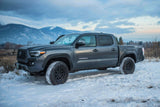Lifted trucks are a statement of strength and durability, but lifting your truck does more than elevate its stance, it also changes the dynamics of its components. Lifted trucks, especially those used for daily driving, experience increased wear and tear on specific parts. From added strain on suspension to faster tire wear, it’s important for owners to be aware of these changes so they can maintain their vehicle’s longevity and performance. Below, we’ll go over the most common parts that are susceptible to wear in lifted trucks and how to best address them.
1. Suspension Components
The suspension system is heavily affected when a truck is lifted. Lifting changes the angles of suspension components like control arms, ball joints, and tie rods, which can result in faster wear. Daily driving on paved roads with a lifted truck means that these parts are constantly under stress, especially on bumps or uneven surfaces.
Solution: To manage this, opt for high-quality suspension components designed specifically for lifted vehicles. Regularly inspect these parts for signs of wear, like squeaking, looseness, or reduced steering responsiveness. Replacing or upgrading components when they show signs of wear will keep the suspension system functioning optimally.
2. Tires and Wheels
A lifted truck often comes with larger tires, which are a major attraction but can lead to increased wear. Larger, heavier tires tend to wear faster, especially if the truck is used for everyday driving. The added weight places extra strain on components like the wheel bearings and axles, which can cause premature wear.
Solution: Regular tire rotations, alignments, and maintaining proper tire pressure can extend tire life and keep wear even. Investing in high-quality, load-rated tires for your specific lift setup can make a significant difference. Routine checks on wheel bearings and axle seals can help detect early signs of wear before they become a major issue.
3. Brakes
The addition of larger tires and wheels not only adds weight to the vehicle but also increases stopping distance, which means your brakes have to work harder. This can result in brake pads and rotors wearing out much faster. For trucks that are frequently driven in traffic or on hilly terrain, this wear can be even more pronounced.
Solution: Upgrading to heavy-duty or performance-grade brake pads and rotors can help handle the extra weight. Routine checks and maintenance on the braking system are essential. Pay attention to any unusual noises or vibrations when braking, as these can indicate wear or the need for immediate service.
4. Drivetrain and Driveshafts
When a truck is lifted, the drivetrain experiences different angles, which can increase the stress on driveshafts and U-joints. Over time, these angles can lead to accelerated wear, especially in trucks used as daily drivers. The added height can also cause vibrations that wear out drivetrain components.
Solution: Consider installing adjustable control arms or a CV driveshaft, which are designed to handle the altered angles. Regular inspections of the U-joints and driveshafts for wear or looseness can help avoid potential issues. Greasing these parts periodically will also help prolong their life.
5. Fuel Economy
While not a “part” of the truck, fuel economy often takes a hit when you lift a truck. The combination of larger tires, altered aerodynamics, and increased weight can lead to a noticeable drop in miles per gallon. Although this isn’t direct wear, it’s a side effect that puts extra strain on your wallet.
Solution: Keeping tires properly inflated, staying up to date on engine maintenance, and driving mindfully can help minimize fuel loss. Some lifted truck owners also consider performance tuning to optimize the engine’s fuel efficiency in light of the added weight.
6. Steering Components
Steering components, including tie rods, ball joints, and the steering box, can undergo additional stress due to the larger tires and altered geometry of a lifted truck. This often results in steering that feels loose or less precise, which can impact the truck’s handling, especially during high-speed driving.
Solution: To manage wear on steering components, consider adding steering stabilizers or using aftermarket components designed for lifted vehicles. Regular checks on the steering system will allow you to detect any early issues, such as loose tie rods or wear in the steering box, and address them before they affect performance.
Maintaining a Lifted Truck for Longevity
Regular maintenance is the key to keeping a lifted truck in great shape. Set up a schedule for routine checks on your suspension, tires, brakes, drivetrain, and steering components. Using high-quality parts and addressing issues early will save time and money in the long run, ensuring your truck runs smoothly on and off the road.
At Reaper Offroad Lifts, we provide quality lift kits online, engineered to give your truck the reliable boost it deserves. Our extensive selection of lift kits and accessories ensures you can find the perfect setup for your vehicle. Explore our range of options and elevate your driving experience today! Don't bury your truck's potential in the ordinary; lift it with Reaper Offroad Lifts and let it become a legend on the road.




0 comments